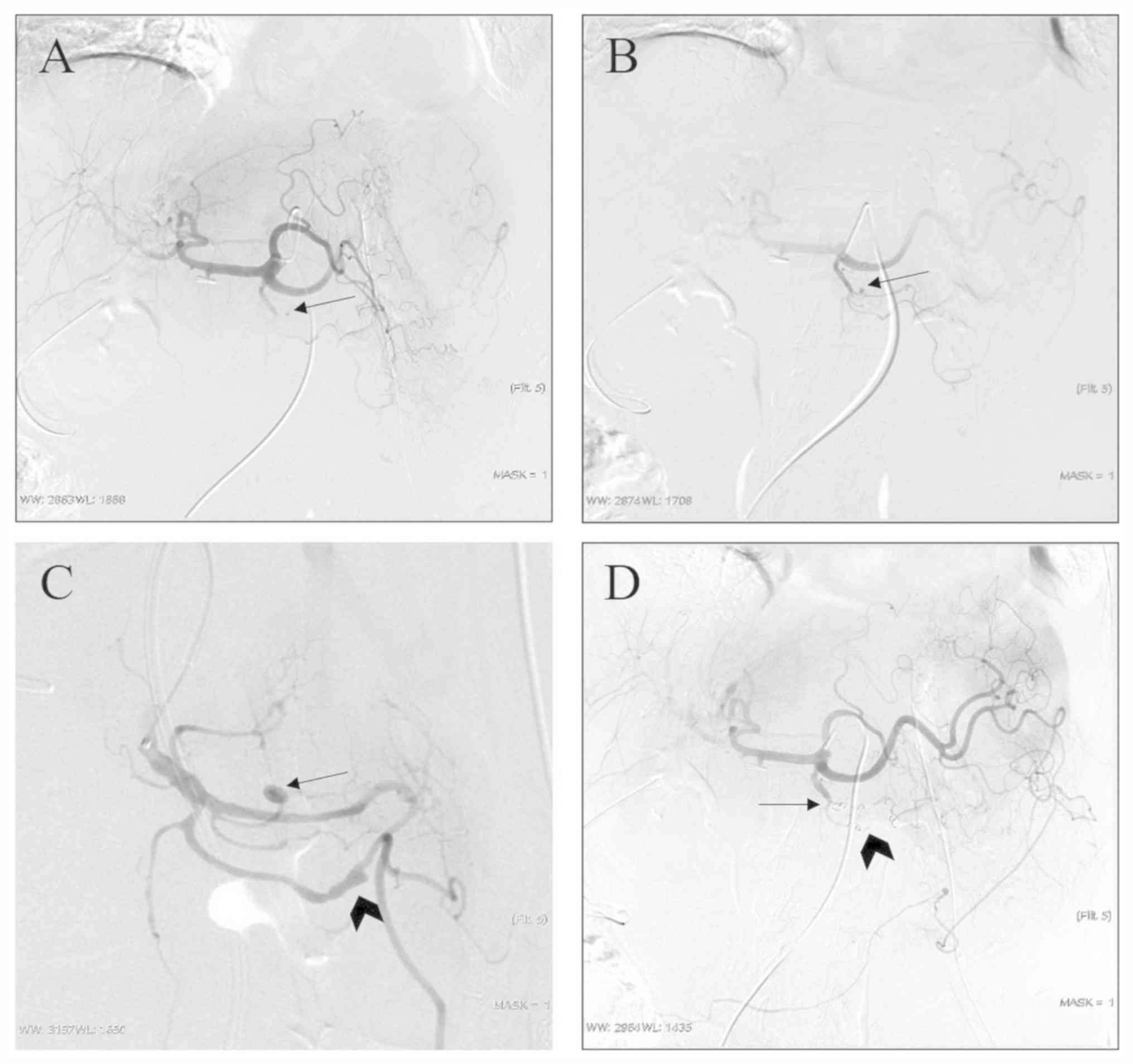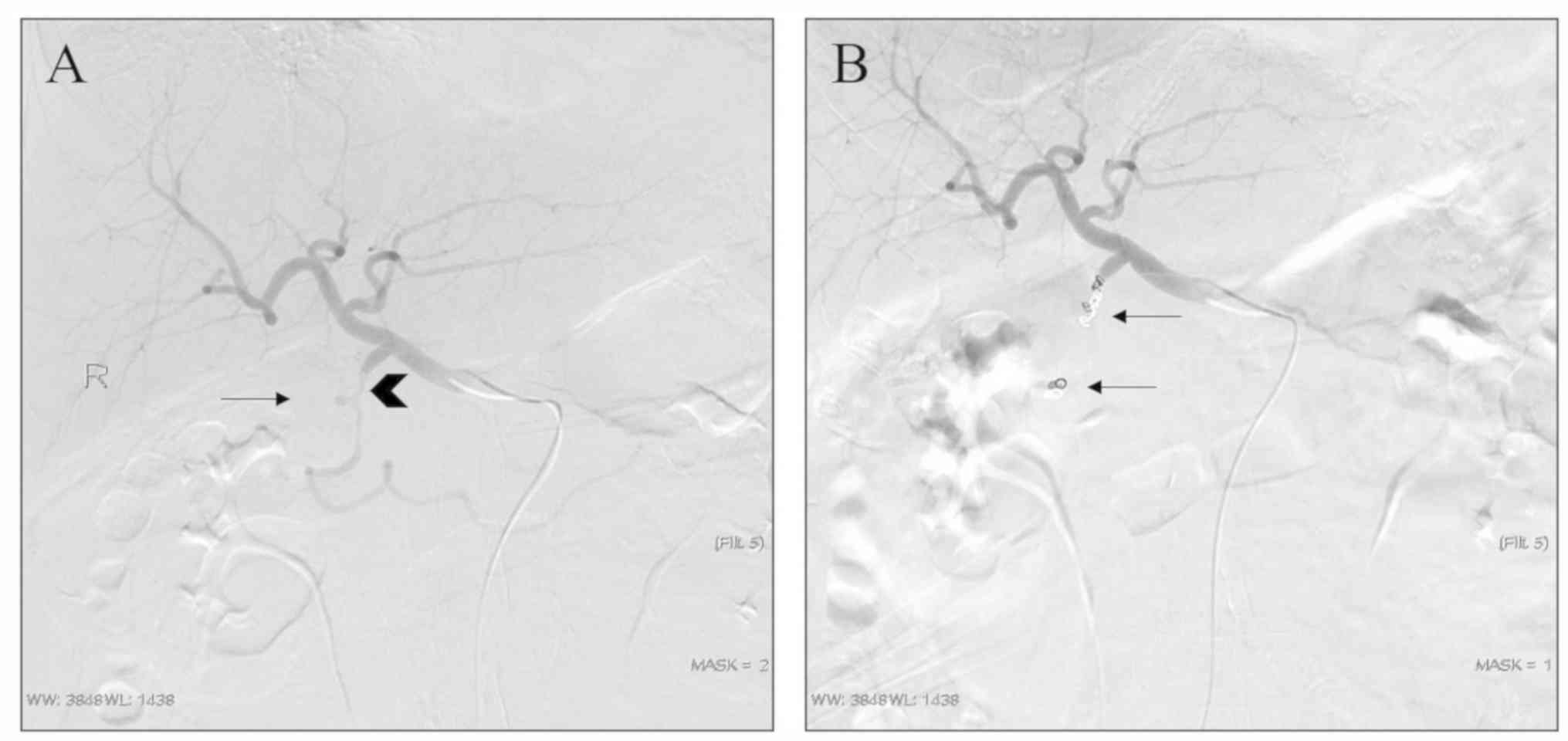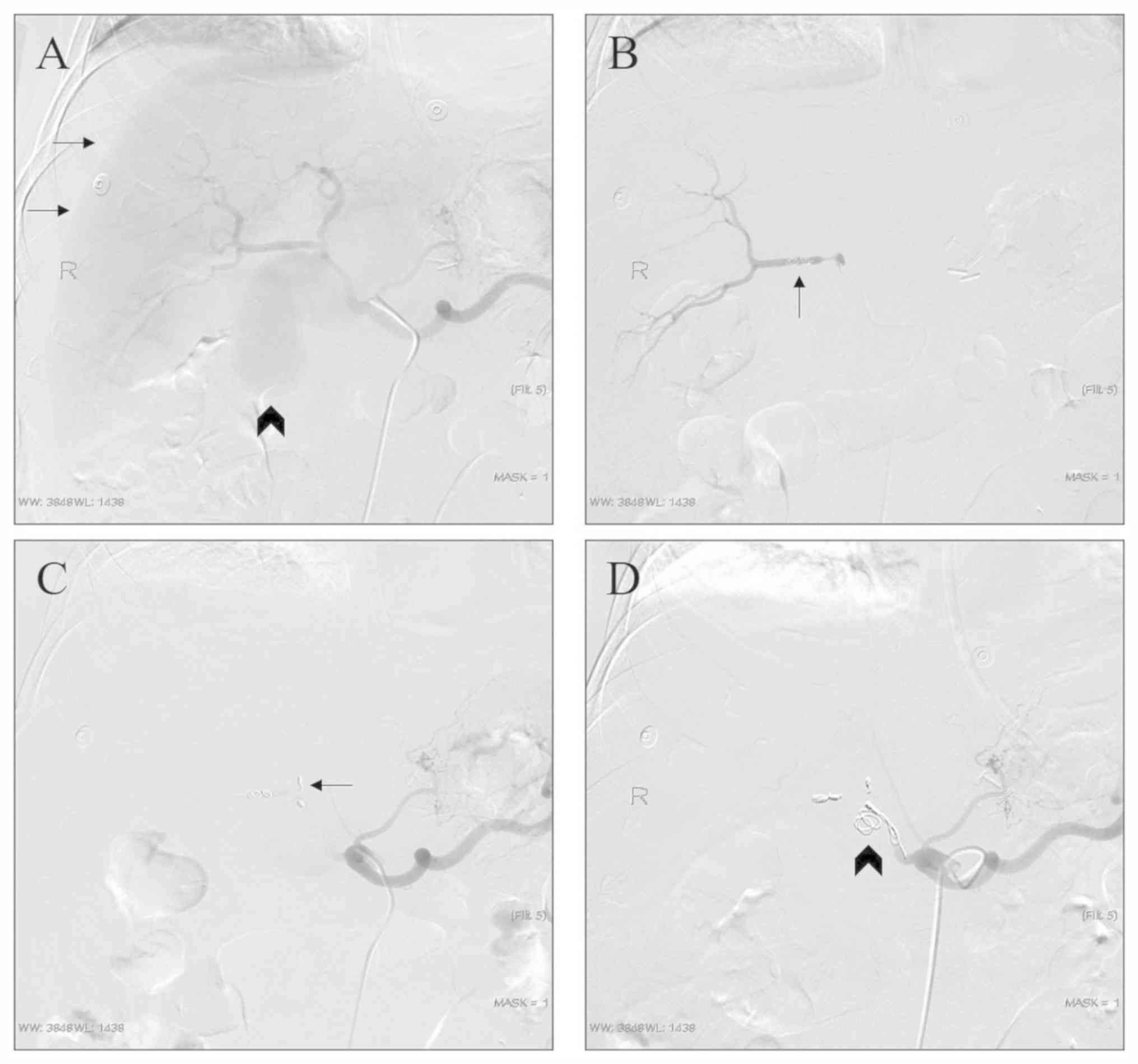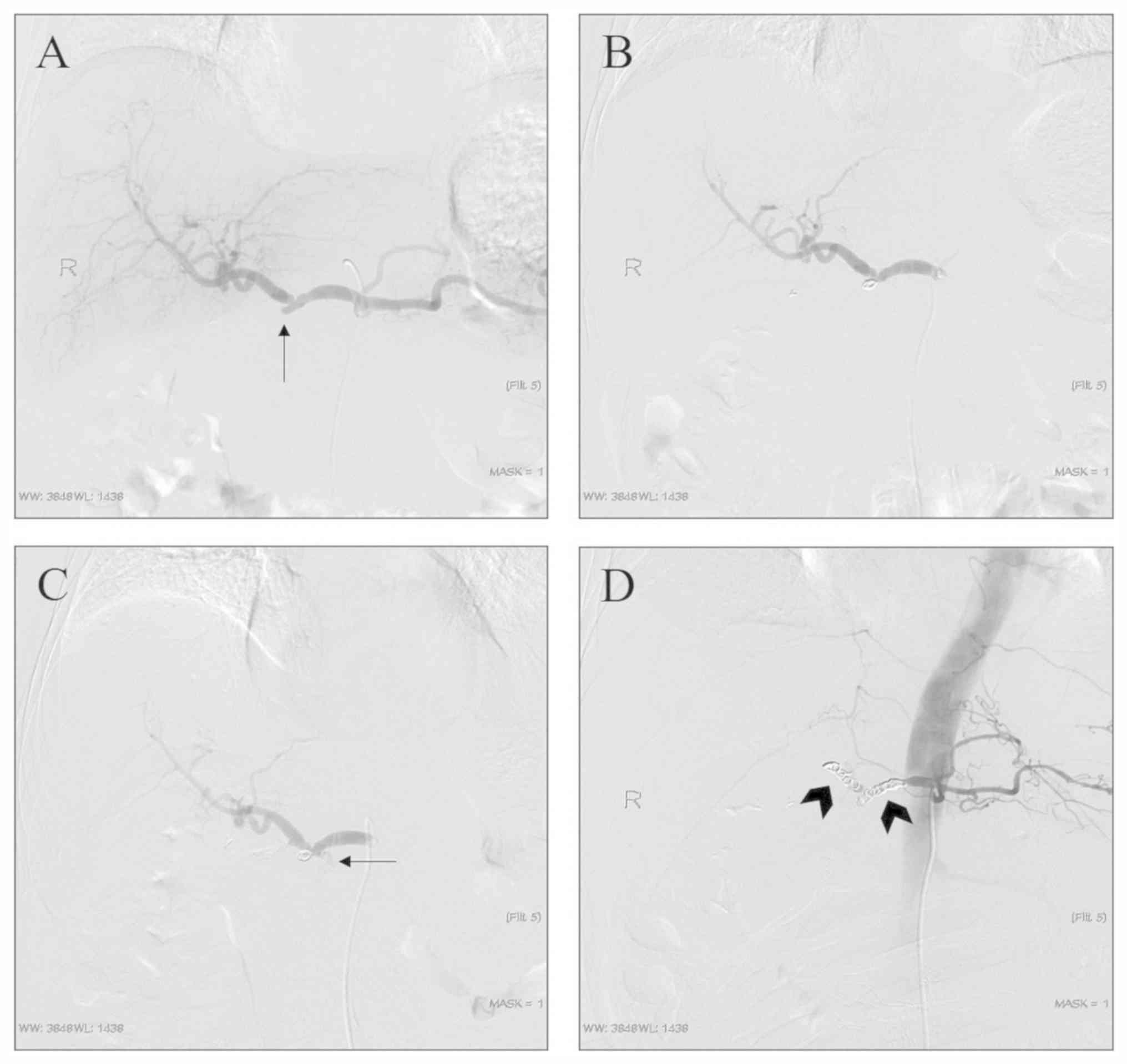|
1
|
McEvoy SH, Lavelle LP, Hoare SM, O'Neill
AC, Awan FN, Malone DE, Ryan ER, McCann JW and Heffernan EJ:
Pancreaticoduodenectomy: Expected post-operative anatomy and
complications. Br J Radiol. 87(20140050)2014.PubMed/NCBI View Article : Google Scholar
|
|
2
|
Qin K, Wu Z, Jin J, Shen B and Peng C:
Internal hernia following robotic assisted pancreaticoduodenectomy.
Med Sci Monit. 24:2287–2293. 2018.PubMed/NCBI View Article : Google Scholar
|
|
3
|
Umemura A, Nitta H, Takahara T, Hasegawa Y
and Sasaki A: Current status of laparoscopic
pancreaticoduodenectomy and pancreatectomy. Asian J Surg.
41:106–114. 2018.PubMed/NCBI View Article : Google Scholar
|
|
4
|
Sato A, Masui T, Nakano K, Sankoda N,
Anazawa T, Takaori K, Kawaguchi Y and Uemoto S: Abdominal
contamination with candida albicans after pancreaticoduodenectomy
is related to hemorrhage associated with pancreatic fistulas.
Pancreatology. 17:484–489. 2017.PubMed/NCBI View Article : Google Scholar
|
|
5
|
Wang M, Cai H, Meng L, Cai Y, Wang X, Li Y
and Peng B: Minimally invasive pancreaticoduodenectomy: A
comprehensive review. Int J Surg. 35:139–146. 2016.PubMed/NCBI View Article : Google Scholar
|
|
6
|
Ammori BJ and Ayiomamitis GD: Laparoscopic
pancreaticoduodenectomy and distal pancreatectomy: A UK experience
and a systematic review of the literature. Surg Endosc.
25:2084–2099. 2011.PubMed/NCBI View Article : Google Scholar
|
|
7
|
Smits FJ, van Santvoort HC, Besselink MG,
Batenburg MCT, Slooff RAE, Boerma D, Busch OR, Coene PPLO, van Dam
RM, van Dijk DPJ, et al: Management of severe pancreatic fistula
after pancreatoduodenectomy. JAMA Surg. 152:540–548.
2017.PubMed/NCBI View Article : Google Scholar
|
|
8
|
Morita S, Tajima T, Yamazaki H, Sonoyama
Y, Nishina Y, Kenji O, Takagi T, Kondo T, Tanabe K and Sakai S:
Early postoperative screening by contrast-enhanced CT and
prophylactic embolization of detected pseudoaneurysms prevents
delayed hemorrhage after partial nephrectomy. J Vasc Interv Radiol.
26:950–957. 2015.PubMed/NCBI View Article : Google Scholar
|
|
9
|
Kendrick ML, van Hilst J, Boggi U, de
Rooij T, Walsh RM, Zeh HJ, Hughes SJ, Nakamura Y, Vollmer CM, Kooby
DA, et al: Minimally invasive pancreatoduodenectomy. HPB (Oxford).
19:215–224. 2017.PubMed/NCBI View Article : Google Scholar
|
|
10
|
Kim E: Embolization therapy for refractory
hemorrhage in patients with patients with chronic subdural
hematomas. World Neurosurg. 101:520–527. 2017.PubMed/NCBI View Article : Google Scholar
|
|
11
|
Liu Y, Wang J, Lin L, Sang C, Lin Z, Pan Y
and Fu X: Clinical study on complications of intracranial reptured
aneurysm embolization by stent-assisted coil. Med Sci Monit.
24:8115–8124. 2018.PubMed/NCBI View Article : Google Scholar
|
|
12
|
Wang Y and Jia P: The role of metallic
clips in transcatheter intravascular embolization for non-variceal
upper gastrointestinal bleeding cases receiving unmnageable
endoscopic therapy: A retrospective cohort study. Int J Surg.
58:26–30. 2018.PubMed/NCBI View Article : Google Scholar
|
|
13
|
Madhusudhan KS, Venkatesh HA, Gamanagatti
S, Garg P and Srivastava DN: Interventional radiology in the
management of visceral artery pseudoaneurysms: A review of
techniques and embolic materials. Korean J Radiol. 17:351–363.
2016.PubMed/NCBI View Article : Google Scholar
|
|
14
|
Wente MN, Veit JA, Bassi C, Dervenis C,
Fingerhut A, Gouma DJ, Izbicki JR, Neoptolemos JP, Padbury RT, Sarr
MG, et al: Postpancreatectomy hemmorrhage (PPH): An international
study group of pancreatic surgery (ISGPS) definition. Surgery.
142:20–25. 2007.PubMed/NCBI View Article : Google Scholar
|
|
15
|
Angle JF, Siddiqi NH, Wallace MJ, Kundu S,
Stokes L, Wojak JC and Cardella JF: Society of Interventional
Radiology Standards of Practice Committee. Quality improvement
guidelines for percutaneous transcatheter embolization: Society of
interventional radiology standards of practice committee. J Vascu
Interv Radiol. 21:1479–1486. 2010.PubMed/NCBI View Article : Google Scholar
|
|
16
|
You Y, Choi SH, Choi DW, Heo JS, Han IW,
Han S, Shin SW, Park KB, Park HS, Cho SK and Han SH: Long-term
clinical outcomes after endovascular management of ruptured
pseudoaneurysm in patients undergoing pancreaticoduodenectomy. Ann
Surg Treat Res. 96:237–249. 2019.PubMed/NCBI View Article : Google Scholar
|
|
17
|
Meyers PM, Shcumacher HC, Higashida RT,
Derdeyn CP, Nesbit GM, Sacks D, Wechsler LR, Bederson JB, Lavine SD
and Rasmussen P: Reporting standards for endovascular repair of
saccular intracranial cerebral aneurysms. AJNR Am J Neuroradiol.
31:E12–E24. 2010.PubMed/NCBI View Article : Google Scholar
|
|
18
|
Hassold N, Wolfschmidt F, Dierks A, Klein
I, Bley T and Kickuth R: Effectiveness and outcome of endovascular
therapy for late-onset postpancreatectomy hemorrhage using covered
stents and embolization. J Vasc Surg. 64:1373–1383. 2016.PubMed/NCBI View Article : Google Scholar
|
|
19
|
Ginat DT, Saad WE and Turba UC:
Transcatheter renal artery embolization: Clinical applications and
techniques. Tech Vasc Interv Radiol. 12:224–239. 2009.PubMed/NCBI View Article : Google Scholar
|
|
20
|
Belli AM, Markose G and Morgan R: The role
of interventional radiology in the management of abdominal visceral
artery aneurysms. Cardiovasc Intervent Radiol. 35:234–243.
2012.PubMed/NCBI View Article : Google Scholar
|
|
21
|
Cordova AC and Sumpio BE: Visceral artery
aneurysms and pseudoaneurysms-should they all be managed by
endovascular techniques? Ann Vasc Dis. 6:687–693. 2013.PubMed/NCBI View Article : Google Scholar
|
|
22
|
Xia W, Zhou Y, Lin Y, Yu M, Yin Z, Lu X,
Hou B and Jian Z: A predictive risk scoring system for clinically
relevant pancreatic fistula after pancreaticoduodenectomy. Med Sci
Monit. 24:5719–5728. 2018.PubMed/NCBI View Article : Google Scholar
|
|
23
|
Dumitru R, Carbunaru A, Grasu M, Toma M,
Ionescu M and Dumitrascu T: Pseudoaneurysm of the splenic artery-an
uncommon cause of delayed hemorrhage after pancreaticoduodenectomy.
Ann Hepatobiliary Pancreat Surg. 20:204–210. 2016.PubMed/NCBI View Article : Google Scholar
|
|
24
|
Gao F, Li J, Quan S, Li F, Ma D, Yao L and
Zhang P: Risk factors and treatment for hemorrhage after
pancreaticoduodenectomy: A case series of 423 patients. Biomed Res
Int. 2016(2815693)2016.PubMed/NCBI View Article : Google Scholar
|
|
25
|
Schäfer M, Heinrich S, Pfammatter T and
Clavien PA: Management of delayed major visceral arterial bleeding
after pancreatic surgery. HPB (Oxford). 13:132–138. 2011.PubMed/NCBI View Article : Google Scholar
|
|
26
|
Feng J, Chen YL, Dong JH, Chen MY, Cai SW
and Huang ZQ: Post-pancreaticoduodenectomy hemorrhage: Risk
factors, managements and outcomes. Hepatobiliary Pancreat Dis Int.
13:513–522. 2014.PubMed/NCBI View Article : Google Scholar
|
|
27
|
Hatzaras I, George N, Muscarella P, Melvin
WS, Ellison EC and Bloomston M: Predictors of survival in
periampullary cancers following pancreaticoduodenectomy. Ann Surg
Oncol. 17:991–997. 2010.PubMed/NCBI View Article : Google Scholar
|
|
28
|
Topal B, Fieuws S, Aerts R, Weerts J,
Feryn T, Roeyen G, Bertrand C, Hubert C, Janssens M and Closset J:
Belgian Section of Hepatobiliary and Pancreatic Surgery.
Pancreaticojejunostomy versus pancreaticogastrostomy reconstruction
after pancreaticoduodenectomy for pancreatic or periampullary
tumours: A multicentre randomised trial. Lancet Oncol. 14:655–662.
2013.PubMed/NCBI View Article : Google Scholar
|
|
29
|
Saad NE, Saad WE, Davies MG, Waldman DL,
Fultz PJ and Rubens DJ: Pseudoaneurysms and the role of minimally
invasive techniques in their management. Radiographics. 25 (Suppl
1):S173–S189. 2005.PubMed/NCBI View Article : Google Scholar
|
|
30
|
Gabelmann A, Görich J and Merkle EM:
Endovascular treatment of visceral artery aneurysms. J Endovasc
Ther. 9:38–47. 2002.PubMed/NCBI View Article : Google Scholar
|
|
31
|
Kamarajah SK: Pancreaticoduodenectomy for
periampullary tumours: A review article based on surveillance, end
results and epidemiology (SEER) database. Clin Transl Oncol.
20:1153–1160. 2018.PubMed/NCBI View Article : Google Scholar
|
|
32
|
Pedrazzoli S and Sperti C: Prevention of
clinically-relevant postoperative pancreatic fistula after
pancreticoduodenectomy. Ann Surg. 269:e7–e8. 2019.PubMed/NCBI View Article : Google Scholar
|
|
33
|
Chadha M and Ahuja C: Visceral artery
aneurysms: Diagnosis and percutaneous management. Semin Intervent
Radiol. 26:196–206. 2009.PubMed/NCBI View Article : Google Scholar
|
|
34
|
Yekebas EF, Wolfram L, Cataldegirmen G,
Habermann CR, Bogoevski D, Koenig AM, Kaifi J, Schurr PG, Bubenheim
M, Nolte-Ernsting C, et al: Postpancreatectomy hemorrhage:
Diagnosis and treatment: An analysis in 1669 consecutive pancreatic
resections. Ann Surg. 246:269–280. 2007.PubMed/NCBI View Article : Google Scholar
|
|
35
|
Jesinger RA, Thoreson AA and Lamba R:
Abdominal and pelvic aneurysms and pseudoaneurysms: Imaging review
with clinical, radiologic, and treatment correlation.
Radiographics. 33:E71–E96. 2013.PubMed/NCBI View Article : Google Scholar
|
|
36
|
Dohan A, Dautry R, Guerrache Y, Fargeaudou
Y, Boudiaf M, Le Dref O, Sirol M and Soyer P: Three-dimensional
MDCT angiography of splanchnic arteries: Pearls and pitfalls. Diagn
Interv Imaging. 96:187–200. 2015.PubMed/NCBI View Article : Google Scholar
|
|
37
|
Guo J, Yu J, Zhang Q and Song X: Clinical
efficacy and safety of uterine artery embolization (UAE) versus
laparoscopic cesarean scar pregnancy debridement surgery (LCSPDS)
in treatment of cesarean scar pregnancy. Med Sci Monit.
24:4659–4666. 2018.PubMed/NCBI View Article : Google Scholar
|
|
38
|
Künzle S, Glenck M, Puippe G, Schadde E,
Mayer D and Pfammatter T: Stent-graft repairs of visceral and renal
artery aneurysms are effective and result in long-term patency. J
Vasc Interv Radiol. 24:989–996. 2013.PubMed/NCBI View Article : Google Scholar
|
|
39
|
Sueyoshi E, Sakamoto I, Nakashima K,
Minami K and Hayashi K: Visceral and peripheral arterial
pseudoaneurysms. AJR Am J Roentgenol. 185:741–749. 2005.PubMed/NCBI View Article : Google Scholar
|
|
40
|
Hur S, Yoon CJ, Kang SG, Dixon R, Han HS,
Yoon YS and Cho JY: Transcatheter arterial embolization of
gastroduodenal artery stump pseudoaneurysms after
pancreaticoduodenectomy: Safety and efficacy of two embolization
techniques. J Vasc Interv Radiol. 22:294–301. 2011.PubMed/NCBI View Article : Google Scholar
|
|
41
|
Kulkarni CB, Moorthy S, Pullara SK and
Kannan RR: Endovascular treatment of aneurysm of splenic artery
arising from splenomesentric trunk using stent graft. Korean J
Radiol. 14:931–934. 2013.PubMed/NCBI View Article : Google Scholar
|
|
42
|
Madhusudhan KS, Gamanagatti S, Garg P,
Shalimar Dash NR, Pal S, Peush S and Gupta AK: Endovascular
embolization of visceral artery pseudoaneurysms using modified
injection technique with N-butyl cyanoacrylate glue. J Vasc Interv
Radiol. 26:1718–1725. 2015.PubMed/NCBI View Article : Google Scholar
|
|
43
|
Leyon JJ, Littlehales T, Rangarajan B,
Hoey ET and Ganeshan A: Endovascular embolization: Review of
currently available embolization agents. Curr Probl Diagn Radiol.
43:35–53. 2014.PubMed/NCBI View Article : Google Scholar
|
|
44
|
Piasek E, Sojka M, Kuczyńska M,
Światłowski Ł, Drelich-Zbroja A, Furmaga O and Jargiełło T:
Visceral artery aneurysms-classification, diagnosis and treatment.
J Ultrason. 18:148–151. 2018.PubMed/NCBI View Article : Google Scholar
|
|
45
|
Pottier E, Ronot M, Gaujoux S, Cesaretti
M, Barbier L, Sauvanet A and Vilgrain V: Endovascular management of
delayed post-pancreatectomy haemorrhage. Eur Radiol. 26:3456–3465.
2016.PubMed/NCBI View Article : Google Scholar
|
|
46
|
Lee HG, Heo JS, Choi SH and Choi DW:
Management of bleeding from pseudoaneurysms following
pancreaticoduodenectomy. World J Gastroenterol. 16:1239–1244.
2010.PubMed/NCBI View Article : Google Scholar
|


















